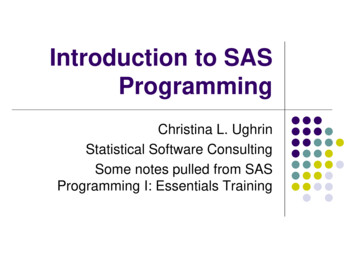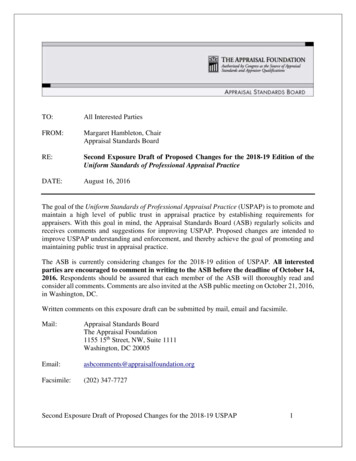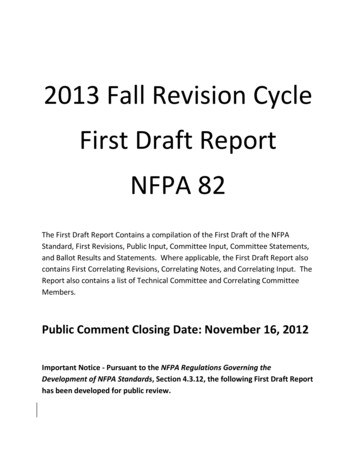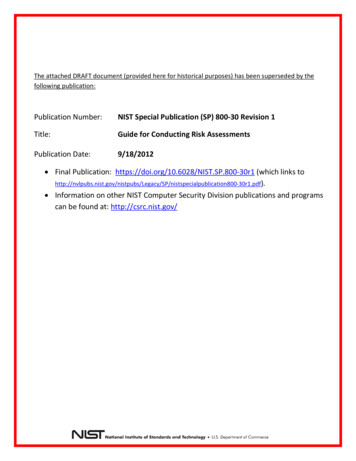
Transcription
Cover should go hereDraft for Comment and RevisionCover should go hereDraft for Comment and RevisionAugust-September 2013Yang-Sheng (Nurturing Life)1
Yang-Sheng (養生 Nurturing Life) is a FREE e-magazine and a network for health care professionals complementary medical practitioners, Qigong, Tai Chi, Yoga, Reiki and other mind-body and spiritcultivators. It promotes methods of self-healing, positive mindfulness and health preservation. YangSheng merges traditional knowledge with modern scientific research and clinical evidence andcombines ancient wisdom with modern experience to support health and well-being.Your participation, contribution, sharing and feedback are truly appreciated.2Yang-Sheng (Nurturing Life)Volume 3, Issue No. 4
Volume 3, No. 4Yang-Sheng Editorial BoardPublisher/Editor: Kevin W Chen, Ph.D.Editor-in-Chief: Michelle WoodAssociate Editors:Master Mantak ChiaHelen Hu, L.Ac. OMDRoger Jahnke, OMD, L.Ac.Rebecca KaliJoy E. Staller, B.ASolala TowlerChristina J. BareaMedical Editor: Sharon Montes, MD.Web Master: Rena ReeseLayout Editor: Marguerite ZietkiewiczColumnists:Ken Andes, L.Ac. D.Ac.Cindy Borgonzi-AregladoEric BorresonTimothy BoothShawn Cartwright, MBA.Salvatore Casano, R.N. Ph.D.Cindy CiceroChris D’Adamo, Ph.D.Felice Dunas, Ph.D.Marty Eisen, Ph.D.Ginger Garner, MPT, ACTChiuan GeeNadia Linda Hole, M.D.Dan KleimanEllasara KlingAihan Kuhn, CMD, Dipl., OBTLinda Lazarus, L.D.Lilly Lei, M.D.Violet LiPhoenix Liu, Ph.D.George Xavier Love, OMDLi-Jun Ma, MD,Ph.D.Elizabeth Mackenzie, Ph.D.Mark Melchiorre, L.Ac.Steffany Moonas, Ph.D.Narij Naik, M.Pharm.Mika OnoRodney J. OwenRebekah F. Owens, LMTRena Reese, M.S.Michael RinaldiniAndy Rosenfarb, L.Ac.Chun Man SitJessica Sommar, MSc.Michael WinnYuan Wang, OMDYang Yang, Ph.D.Tina Chunna ZhangSam ZhaoConsulting Editors:Master Kenneth CohenEffie Chow, L.Ac, Ph.DFaxiang Hou.Livia Kohn, Ph.D.Tianjun Liu, OMDNan Lu, OMD. L.Ac.Guan-Cheng Sun, Ph.D.Lama Somananda TantrapaMaster Zhongxian WuTony Zhuo, OMDAugust-September 2013www.Yang-Sheng.com (ISSN: 2326-277X)Aug-Sep 2013TABLE OF CONTENTSFrom the Editor 编者的话 . . . . . . . . . 5Meditation in Motion 动中冥想. 6Jing—Mental Quietness and Serenityby Eric BorresonResearch Update 科研 动态 . . . . . 7Mind-Body Medicine Research Updateby Kevin ChenThe Dancing Doc 舞 医 . . . . . 14Harmony with Nature: Healing Rhythms – Human, Moon, Earth, and Sunby Sharon Montes, MDWuji in Motion 动中无极 . . . . . 20You Can’t Do QiGongby Rodney OwenFeatured Article 精选文章 . . . . 22Opening the Body to Natureby Rene J. Navarro, Dipl. Ac. (NCCAOM)Experience Exchange 经验交流 . . . . 25Can You Be Like Water?by Bob McBrien & Vincent GuiterrezCultivating the Mind 养心斋 . . . . 27Amazing Food - The Gift of Nature: Coordinating Diet and NatureMood, Food and Move - Three Secrets Part IIIby Shiuan GeeScientific Qi Exploration 气的科学探索 . . . . . . 29Part 1. The Collateralsby Marty EisenQiGong News 气功新闻 . 34Qigong Institute Founder and CEO Ken Sancier Past Awayby Tom Rogers, PresidentMethod of Self Healing 自愈法 . . . . . . 36The Concept of Harmony Related to Daoist Yang-shengand Western Medical Thoughtby Matthew BanksSeasonal Harmony 季节的和谐 . . . . 41Everything Flows Heraclitus of Ephesus (6th Century BCE)by Ellasara KlingComedy Moment 开心一刻 . 45Support Yang-Sheng . 46Yang-Sheng (Nurturing Life)3
4Yang-Sheng (Nurturing Life)Volume 3, Issue No. 4
From the Editor 编者的话Welcome to the August/September issue of Yang Sheng Magazine! Asalways, our columnists have provided many excellent articles with verydiverse perspectives on the theme. This month our theme is Harmony WithNature.Our feature article by Rene Navarro explains why it is not onlybene icial but imperative that we live a lifestyle that is harmonious withnature. He also offers practices that are deceptively simple but easymethods when you approach them with sincerity and intention anddedication. Sharon Montes offers great information on biorhythms andways to be in harmony with lunar phases and solar seasons, environment,and even with ourselves.In separate articles, Eric Borreson, Rodney Owen, and Bob McBrien with his student VincentGuiterrez, demonstrate the different ways that harmony may be achieved through practices likemeditation and taiji and qigong. There truly is something for everyone when it comes to achieving astate of relaxation and inner peace. For you science-minded readers, we offer Publisher Kevin Chen'scompilation of research updates showing the bene its and ef icacy rates of practices like meditation,taiji, qigong, and yoga.Dr. Marty Eisen writes this month about the energy channels in the body known as TheCollaterals. Matt Banks writes about harmony from the perspective of the differences and thesimilarities between Eastern and Western medicine and culture.And inally, the favorite topic of many people I know (maybe you, too!), Shiuan Gee and EllasaraKling offer information on our harmonious relationship with food! I invite you to relax with a cup oftea, or a glass of your favorite beverage, and enjoy this issue of YangSheng (Nurturing Life) Magazine.Many Blessings!Michelle MoodEditor-in-ChiefDisclaimer: Information included on www.yang-sheng.com and in Yang-Sheng e-magazine is for the general information of the reader.While we attempt to include a wide variety of information on subjects related to Yang-Sheng; opinions expressed are those of theauthors of articles and do not necessarily state or reflect the views of Yang-Sheng, the publisher or editors. In addition, informationincluded on www.yang-sheng.com and in Yang-Sheng e-magazine is not intended nor implied to provide medical advice.August-September 2013Yang-Sheng (Nurturing Life)5
Meditation in Motion动中冥想Jing – Mental Quietness and SerenityBy Eric BorresonJing is a mental phase where the mind quietsdown and ignores the mental chatter that we arenormally bombarded with. Jing means to be focusedand aware of your self and your surroundings. Ithas been said that Sun Lu-Tang, creator of Sun styletai chi, claimed that the highest level of tai chi iswhen it merges with the Dao and one is in harmonywith nature.Tai chi practice can develop your ability to movefrom your learning mind to your performance mind.Learning mind (conscious mind) – The learningmind is engaged when learning the form. We practice each part and put them together into the form,linking each part together. We then begin integrating the essential principles into the whole.Performance mind (subconscious mind) – Withpractice, the form becomes second nature. Thelearning mind begins to give way to the performance mind. As the performance mind takes over,the mind begins to lead the body and mental quietness develops.It can take time to develop a quiet mind. It improves with practice. With each successive practice,it takes less time to return to a quiet mind. Gradually, you will be able to move to a higher level withbetter focus. Mental quietness calms the monkeymind that bombards us with random, jumpythoughts. It helps us cope with stress and crisis.During practice, seek serenity in activity. Whenpracticing the forms, it is generally better to movevery slowly with even speed. Focus on slow andgentle breathing. Push gently through the air as if itis thick like honey. Keep your focus on your body. Beaware of substantial and insubstantial. Keep yourbody aligned and your joints loose. Please see6Yang-Sheng (Nurturing Life)“Relax and Loosen in Taiji” (September 2012) foradditional information: http://yang-sheng.com/?p 8401Maintain an upright posture. Concentrate onyour dan tien. When you exhale, gently contract themuscles in the lower abdomen and pelvis whilekeeping the muscles still above your belly button.Imagine that you are bringing your pelvic loor justa little closer to your belly button. When you inhale,allow the muscles to relax while maintaining a littlebit of the muscle contraction. Slow movements helpyou breathe deeply and help to sink the qi to thedan tien.Jing works to promote calmness and serenity.When you use your mind actively to focus on andenhance your body movements, you build a strongmind/body connection. Your energy follows yourintention. In addition, jing activates our parasympathetic nervous system. This calms our body and reverses the effect of stress. People often ind that jingimproves their ability to handle stress. This is Meditation in Motion where you can ind harmony withnature.Eric Borreson – a student andteacher, finds teaching taiji,qigong, and meditation to be a pathto a more meaningful life. Eric isthe founder and director of Meditation in Motion, specializing inteaching about living healthier andhappier lives. He teaches taiji,qigong, and meditation at the prestigious Heartland Spa,a top 10 destination spa, located in Gilman, IL. In addition, he teaches taiji (Yang 24, Sun-style taiji, and Dr.Lam’s Taiji for Arthritis and Taiji for Diabetes) at othervenues. He conducts workshops and teaches private lessons on request. He writes a weekly wellness column athttp://eric-taichi.blogspot.com.Volume 3, Issue No. 4
Research Update 科研动态Mind-Body MedicineResearch UpdateCompiled by Kevin W Chen, Ph.D.Effects of qigong exercise on fatigue, anxiety, anddepressive symptoms of patients with chronic fatigue syndrome-like illness: a randomized controlled trial. Evid Based Complement AlternatMed. 2013; 2013:485341. Epub 2013 Jul 31. ByChan JS, Ho RT, Wang CW, Yuen LP, Sham JS,Chan CL. from Centre on Behavioral Health, TheUniversity of Hong Kong, Hong Kong.BACKGROUND: Anxiety/depressive symptomsare common in patients with chronic fatigue syndrome-(CFS-) like illness. Qigong as a modality ofcomplementary and alternative therapy has been increasingly applied by patients with chronic illnesses,but little is known about the effect of Qigong onanxiety/depressive symptoms of the patients withCFS-like illness.PURPOSE: To investigate the effects of Qigongon fatigue, anxiety, and depressive symptoms in patients with CFS-illness. Methods. One hundred andthirty-seven participants who met the diagnostic criteria for CFS-like illness were randomly assigned toeither an intervention group or a waitlist controlgroup. Participants in the intervention group received 10 sessions of Qigong training twice a weekfor 5 consecutive weeks, followed by home-basedpractice for 12 weeks. Fatigue, anxiety, and depressive symptoms were assessed at baseline andpostintervention.RESULTS: Total fatigue score [F(1,135) 13.888,P 0.001], physical fatigue score [F(1,135) 20.852, P 0.001] and depression score [F(1,135) 9.918, P 0.002] were significantly improved andAugust-September 2013mental fatigue score [F(1,135) 3.902, P 0.050]was marginally significantly improved in the Qigonggroup compared to controls. The anxiety score wasnot significantly improved in the Qigong group.CONCLUSION. Qigong may not only reduce thefatigue symptoms, but also has antidepressive effectfor patients with CFS-like 485341/Effectiveness of T'ai Chi and Qigong on Chronic Obstructive Pulmonary Disease: A SystematicReview and Meta-Analysis. J Altern ComplementMed. 2013 Aug 20. [Epub ahead of print] by DingM, Zhang W, Li K, Chen X. from College of Physical Education, Shandong Normal University , Jinan,China .PURPOSE: The purpose of this study is to determine the effects of Chinese traditional exercise suchas t'ai chi and qigong (TCQ) on patients with chronicobstructive pulmonary disease (COPD). Methods:All prospective, randomized, controlled clinical trials, published in English or Chinese and involvingthe use of TCQ by patients with COPD, weresearched in 10 electronic databases from their respective inceptions to July 2012. The methodological quality of all studies was assessed using theJadad score. The selection of studies, data extraction,and quality assessment were performed independently by two raters. Results: In the results, 10 trials metthe inclusion criteria and were reviewed. The metaanalysis demonstrated that compared with no exercise, TCQ had significant effects on 6-minute walkYang-Sheng (Nurturing Life)7
distance, forced expiratory volume in 1 second(FEV1), predicted FEV1 percentage, and St.George's Respiratory Questionnaire score. Therewere no significant differences in all outcomes between TCQ and other exercise training except 6minute walk distance. Conclusions: In conclusion,TCQ might be beneficial with respect to physicalperformance, lung function, remission of dyspnea,and quality of life in patients with COPD; however,caution is needed to draw a firm conclusion becauseof the low methodological quality of the includedtrials.Psychosocial and Cardiac Outcomes ofYoga for ICD Patients: A Randomized ClinicalControl Trial. Pacing Clin Electrophysiol. 2013Aug 26. By Toise SC, Sears SF, Schoenfeld MH, etal. from Yale-New Haven Hospital, New Haven,Connecticut.BACKGROUND: Because as many as46% of implantable cardioverter defibrillator (ICD) patients experience clinical symptoms of shock anxiety, this randomized controlled study evaluated the efficacy ofadapted yoga (vs usual care) in reducingclinical psychosocial risks shown to impactmorbidity and mortality in ICD recipients.METHODS: Forty-six participants wererandomized to a control group or an 8-week adaptedyoga group that followed a standardized protocolwith weekly classes and home practice. Medical andpsychosocial data were collected at baseline and follow-up, then compared and analyzed.RESULTS: Total shock anxiety decreased for theyoga group and increased for the control group,t (4.43, 36), P 0.0001, withsignificant differences between these changes. Similarly, consequential anxiety decreased for the yoga groupbut increased for the controlgroup t(2.86,36) P 0.007.Compared to the control, theyoga group had greater overall self-compassion, t(-8Yang-Sheng (Nurturing Life)2.84,37), P 0.007, and greater mindfulness, t(-2.10,37) P 0.04, at the end of thestudy. Exploratory analysesutilizing a linear model (R2 0.98) of observed devicetreated ventricular (DTV)events revealed that the expected number of DTVevents in the yoga group wassignificantly lower than inthe control group (P 0.0001). Compared to thecontrol, the yoga group had a 32% lower risk of experiencing device-related firings at end of followup.CONCLUSIONS: Our study demonstrated psychosocial benefits from a program of adapted yoga (vs usual care) forICD recipients. These data support continued research to better understand therole of complementary medicine to address ICD-specific stress in cardiac outcomes.Multicenter, Randomized ControlledTrial of Yoga for Sleep Quality AmongCancer Survivors. J Clin Oncol. 2013Aug 12. [Epub ahead of print] by Mustian KM,Sprod LK, Janelsins M, et al. from University ofRochester Medical Center, Rochester, NY; and other institutes.PURPOSE: Thirty percent to 90% of cancer survivors report impaired sleep quality post-treatment,which can be severe enough to increase morbidityand mortality. Lifestyle interventions, such as exercise, are recommended in conjunction with drugsand cognitive behavioral therapy for the treatmentof impaired sleep. Preliminary evidence indicatesthat yoga-a mind-body practice and form of exercise-may improve sleep among cancer survivors. Theprimary aim of this randomized, controlled clinicaltrial was to determine the efficacy of a standardizedyoga intervention compared with standard care forimproving global sleep quality (primary outcome)Volume 3, Issue No. 4
amongposttreatment cancersurvivors.PATIENTS &METHODS: Inall, 410 survivorssufferingfrommoderate or greater sleep disruptionbetween 2 and 24months after surgery, chemotherapy, and/or radiation therapy were randomly assigned to standardcare or standard care plus the 4-week yoga intervention. The yoga intervention used the Yoga for Cancer Survivors (YOCAS) program consisting of pranayama (breathing exercises), 16 Gentle Hatha andRestorative yoga asanas (postures), andmeditation. Participants attended two 75-minute sessions per week. Sleep qualitywas assessed by using the PittsburghSleep Quality Index and actigraphy preand postintervention.RESULTS: In all, 410 survivors wereaccrued (96% female; mean age, 54years; 75% had breast cancer). Yogaparticipants demonstrated greater improvements in global sleep quality and, secondarily,subjective sleep quality, daytime dysfunction, wakeafter sleep onset, sleep efficiency, and medicationuse at postintervention (all P .05) compared withstandard care participants.CONCLUSION: Yoga, specifically the YOCASprogram, is a useful treatment for improving sleepquality and reducing sleep medication use amongcancer survivors.Effectiveness of controlled breathing techniqueson anxiety and depression in hospitalized COPD:a randomized clinical trial. Respir Care. 2013 Jul23. By Valenza MC, Valenza-Peña G, TorresSánchez I, et al. from Physical Therapy Department,University of Granada, Granada, Spain.BACKGROUND: Anxiety and depression areAugust-September 2013highly prevalent comorbid complications in COPD.Breathing techniques can improve anxiety and depression in subjects hospitalized due to COPD exacerbation. We conducted a randomized clinical studyusing two groups. The sample comprised 46 malepatients aged 67-86 years hospitalized with acuteCOPD exacerbation. Patients were randomly andequally divided into the control and controlledbreathing intervention groups.The sample comprised46 male patients aged 67-86 years hospitalized withacute COPD exacerbation. Patients were randomlyand equally divided into the control and controlledbreathing intervention groups.METHODS: Baseline and post-intervention recordings of Dyspnea, Anxiety and depression, Quality of life (SGRQ and EURQoL), Respiratory pressures (PImax-PEmax), Hand-griptest and Sleep quality were taken inall subjects. Subjects hospitalizeddue to acute COPD exacerbationshowed high levels of dyspnea andlow values in overall quality of lifeas measured with the St. George'sRespiratory Questionnaire (SGRQ).RESULTS: Controlled breathingtechniques had a significant effecton dyspnea, anxiety and mobility (p 0.05). All themeasured areas were improved in the interventiongroup. The control group had poorer values in all theareas after the hospitalization period.CONCLUSIONS: Controlled breathing exercisesbenefit patients hospitalized due to COPD exacerbation in anxiety and depression values.The effect ofqigong on depressive and anxietysymptoms: a systematicreviewand meta-analysisofrandomizedcontrolled trials.Evid Based Complement AlternatYang-Sheng (Nurturing Life)9
Med. 2013;2013:716094. By Wang CW, Chan CL,Ho RT, et al. From Centre on Behavioral Health,The University of Hong Kong.OBJECTIVE: To evaluate clinical trial evidence ofthe effectiveness of qigong exercise on depressiveand anxiety symptoms.METHODS: Thirteen databases were searchedfrom their respective inception through December2012. Relevant randomized controlled trials (RCTs)were included. Effects of qigong across trials werepooled. Standardized mean differences (SMDs) werecalculated for the pooled effects. Heterogeneity wasassessed using the I (2) test. Study quality was evaluated using the Wayne Checklist.RESULTS: Twelve RCTs met the inclusion criteria. The results of meta-analyses suggested a beneficial effect of qigong exercise on depressive symptoms when compared to waiting-list controls or usual care only (SMD -0.75; 95% CI, -1.44 to -0.06),group newspaper reading (SMD -1.24; 95% CI, 1.64 to -0.84), and walking or conventional exercise(SMD -0.52; 95% CI, -0.85 to -0.19), which mightbe comparable to that of cognitive-behavioral therapy (P 0.54). Available evidence did not suggest abeneficial effect of qigong exercise on anxietysymptoms. Conclusion. Qigong may be potentiallybeneficial for management of depressive symptoms,but the results should be interpreted with caution dueto the limited number of RCTs and associated methodological weaknesses. Further rigorously designedRCTs are 3/716094/YOGA FOR DEPRESSION: A SYSTEMATICREVIEW AND META-ANALYSIS. DepressAnxiety. 2013 Aug 6. [Epub ahead of print] byCramer H, Lauche R, Langhorst J, Dobos G. fromDept of Internal and Integrative Medicine, Faculty ofMedicine, University of Duisburg-Essen, Essen,Germany.BACKGROUND: Mind-body medical interventions are commonly used to cope with depressionand yoga is one of the most commonly used mindbody interventions. The aim of this review was tosystematically assess and meta-analyze the effectiveness of yoga for depression.METHODS: Medline/PubMed, Scopus, theCochrane Library, PsycINFO, and IndMED weresearched through January 2013. Randomized controlled trials (RCTs) of yoga for patients with depressive disorders and individuals with elevated levels of depression were included. Main outcomeswere severity of depression and the re-mission rates,secondary outcomes were anxiety, quality of life,and safety.RESULTS: Twelve RCTs with 619 participantswere included. Three RCTs had low risk of bias. Regarding severity of depression, there was moderateevidence for short-term effects of yoga compared tousual care (standardized mean difference (SMD) 0.69; 95% confidence interval (CI) -0.99, -0.39; P .001), and limited evidence compared to relaxation(SMD -0.62; 95%CI -1.03, -0.22; P .003), andaerobic exercise (SMD -0.59; 95% CI -0.99, -0.18;P .004). Limited evidence was found for shortterm effects of yoga on anxiety compared to relaxation (SMD -0.79; 95% CI -1.3, -0.26; P .004).Subgroup analyses revealed evidence for effects inpatients with depressive disorders and in individualswith elevated levels of depression. Due to the paucity and heterogeneity of the RCTs, no meta-analyseson long-term effects were possible. No RCT reported safety data.CONCLUSION:10Yang-Sheng (Nurturing Life)Despite methodological drawVolume 3, Issue No. 4
backs of included studies, yoga could be consideredan ancillary treatment option for patients with depressive disorders and individuals with elevated levels of depression.Effects of Qigong Exercise on Upper LimbLymphedema and Blood Flow in Survivors ofBreast Cancer: A Pilot Study. Integr Cancer Ther.2013 Jun 7. By Fong SS, Ng SS, Luk WS, et al.from Institute of Human Performance, The University of Hong Kong, Hong Kong.ABSTRACT: Hypothesis. Qigong exercise is apopular method for relieving the side effects of conventional cancer treatments in survivors of breastcancer, yet its effects are not empirically assessed.This study aimed to investigate the effects of qigongexercise on upper limb lymphedema, arterial resistance, and blood flow velocity in survivors withbreast cancer and mastectomy.STUDY DESIGN: This study was conducted as aprospective clinical trial.METHODS: Eleven survivors of breast cancerwith qigong experience (mean age 58.3 10.1years) were assigned to the experimental group and12 survivors of breast cancer without qigong experience (mean age 53.8 4.2 years) were assigned tothe control group. They all had breast cancer-relatedlymphedema. All procedures were completed withinone session. After baseline measurements were taken, the experimental group performed 18 Forms TaiChi Internal Qigong for approximately 6 minutesAugust-September 2013while the control group rested for similar duration ina sitting position. Both groups were then reassessed.All participants were measured on their affected upper limb circumference (by using tape measures),peripheral arterial resistance, and blood flow velocities (using a Doppler ultrasound machine).RESULTS: The between-group differences werenot significant for all outcome measures at baseline(P .05). The circumferences of the affected upperarm, elbow, forearm and wrist decreased afterqigong exercise (P .05). However, no significantdifference was found in the circumference measuresbetween the 2 groups posttest (P .0125). In termsof vascular outcomes, the resistance index decreasedand the maximum systolic arterial blood flow velocity (SV) and minimum diastolic arterial blood flowvelocity (DV) increased significantly after qigongexercise (P .05). The between-group differencewas close to significant for SV (P .018) and wassignificant for DV (P .001) posttest.CONCLUSION: Qigong exercise could reduceconventional cancer therapy side effects such as upper limb lymphedema and poor circulatory status insurvivors of breast cancer. However, such effectsmay be temporary, and further studies must be conducted to explore longer term effects. Effects of yoga therapy on postural stability in patients withschizophrenia-spectrum disorders: A single-blindrandomized controlled trial. J Psychiatr Res. 2013Aug 8. [Epub ahead of print] by Ikai S, Uchida H,Suzuki T, et al. from Dept of Neuropsychiatry, Yamanashi Prefectural Kita Hospital, Yamanashi, Japan; sako0609@gmail.com.INTRODUCTION: Postural instability is a serious concern in patients with schizophrenia-spectrumdisorders since it is expected to increase the risk offalls that may lead to fractures. The impact of yogatherapy on postural stability has not been investigated.METHODS: In this eight-week single-blind randomized controlled study with an eight-week follow-up, outpatients with schizophrenia or related psychotic disorder (ICD-10) were randomly assigned toYang-Sheng (Nurturing Life)11
either yoga therapy or a control group. In the yogatherapy group, the subjects received weekly sessionsof 60-min yoga therapy for eight weeks in additionto their ongoing treatment. In the control group, thesubjects received a weekly regular day-care program. The assessments that were performed at thebaseline and endpoint included the Clinical Stabilometric Platform (CSP), anteflexion in standing.RESULTS: Forty-nine patients participated in thisstudy (32 men; mean SD age, 53.1 12.3 years):yoga therapy group (n 25) and control group (n 24). In the yoga group, significant improvementswere observed in a total length of trunk motion, theRomberg ratio, and anteflexion in standing at week 8(mean SD: 63.9 40.7-53.4 26.2 cm, 1.6 0.91.1 0.6, and -8.7 9.5 to -3.8 12.4 cm, respectively) while there were no significant changes in thecontrol group. However, those clinical gains returned to the baseline level at week 16. CONCLUSIONS: The results confirmed the beneficial effectsof the yoga therapy on postural stability in patientswith schizophrenia. However, the therapeutic effectsseemed transient, which warrants further investigations on strategies to sustain the improvements.Randomized Controlled Trial of MindfulnessBased Cancer Recovery Versus Supportive Expressive Group Therapy for Distressed Survivorsof Breast Cancer (MINDSET). J Clin Oncol. 2013Aug 5. [Epub ahead of print] by Carlson LE, Doll R,Stephen J, et al. from Alberta Health Services, Calgary, Alberta; Canada.PURPOSE: To compare the efficacy of the following two empirically supported group interventions tohelp distressed survivors of breast cancer cope:mindfulness-based cancer recovery (MBCR) andsupportive-expressive group therapy (SET).PATIENTS AND METHODS: This multisite,randomized controlled trial assigned 271 distressedsurvivors of stage I to III breast cancer to MBCR,SET, or a 1-day stress management control condition. MBCR focused on training in mindfulnessmeditation and gentle yoga, whereas SET focusedon emotional expression and group support. Bothintervention groups included 18 hours of profession-12Yang-Sheng (Nurturing Life)al contact. Measures were collected at baseline andafter intervention by assessors blind to study condition. Primary outcome measures were mood and diurnal salivary cortisol slopes. Secondary outcomeswere stress symptoms, quality of life, and social support.RESULTS: Using linear mixed-effects models, inintent-to-treat analyses, cortisol slopes were maintained over time in both SET (P .002) and MBCR(P .011) groups relative to the control group,whose cortisol slopes became flatter. Women inMBCR improved more over time on stress symptoms compared with women in both the SET (P .009) and control (P .024) groups. Per-protocolanalyses showed greater improvements in theMBCR group in quality of life compared with thecontrol group (P .005) and in social support compared with the SET group (P .012).CONCLUSION: In the largest trial to date,MBCR was superior for improving a range of psychological outcomes for distressed survivors ofbreast cancer. Both SET and MBCR also resulted inmore normative diurnal cortisol profiles than thecontrol condition. The clinical implications of thisfinding require further investigation.Effects of meditation on anxiety, depression,fatigue, and quality of life of women undergoingVolume 3, Issue No. 4
radiation ) therapy for breast cancer. Complement Ther Med. 2013 Aug;21(4):379-87. By KimYH, Kim HJ, Ahn SD, Seo YJ, Kim SH. From Deptof Nursing, Asan Medical Center, Seoul, Republicof Korea.ropean Organization for Research and Treatment ofCancer-Quality of Life Core-30. The results wereanalyzed based on the principles of intention-to-treatanalysis, and, as a corollary analysis, per-protocolanalysis was conducted.OBJECTIVE: To investigate the effects of meditation on anxiety, depression, fatigue, and quality oflife in women who are receiving radiation therapyfor breast cancer.RESULTS: The breast cancer patients who received meditation therapy compared with the nonintervention group saw improvements in reductionof anxiety (p .032), fatigue (p .030), and improvement in global quality of life (p .028).CO
2 Yang-Sheng (Nurturing Life) Volume 3, Issue No. 4 Yang-Sheng (養生 Nurturing Life) is a FREE e-magazine and a network for health care professionals - complementary medical practitioners, Qigong, Tai Chi, Yoga, Reiki and other mind-body and spirit cultivators. It promotes methods of se











